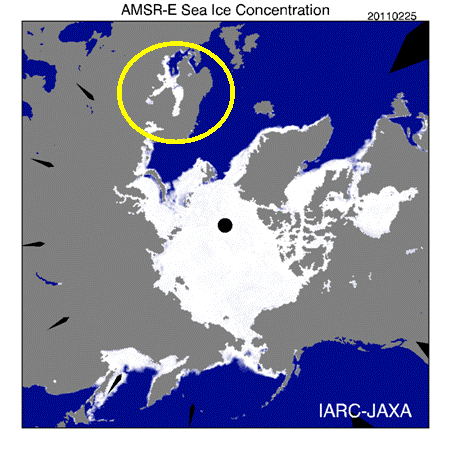Sweden’s meteorological agency reports that ice coverage on the Baltic Sea is greater than it’s been in nearly a quarter century. Read more here.
About 250,000 square kilometres of the Baltic Sea are now covered in ice according to the Swedish Meteorological and Hydrological Institute (SMHI).
The last time so much of the Baltic was frozen was the winter of 1986-87, when ice covered nearly 400,000 square kilometres of the sea’s surface.
SMHI warns that ice coverage on the Baltic could expand further in the coming days, possibly setting a new record.
The area of interest is in the circle.






It is a very interesting situation. December 2010 came up with a lot of sea, details here: http://www.2007seatraining.de/Archiv/dec2_10.html, but due to the modest winter condition in January the icing only exceeded average conditions since about the 10th of February, as discussed here http://www.2007seatraining.de/. But much more can be expected, as the Baltic countries seem to get further frosty days (with –15°) until early March.
A minimum in an area that accounts for less than 1.8% of Arctic Sea Ice, during a season that’s *still* below the 2006/7 minima!:
http://nsidc.org/data/seaice_index/images/daily_images/N_stddev_timeseries.png
That proves less than nothing.
Boah! Amazing observation, Edwin.
Edwin @ 11:06
That proves less than nothing.
I’m tempted to question your rationality based on the above statement, but I’ll just assume the “less” slipped in there as your fingers flew across the keys.
However, if you do have something relevant to say about this season’s ice in the Baltic, I’d be interested. I live about 135° Long. away with no personal, academic, research or other experience about this Sea and would like to learn more from those that do have first hand knowledge.
Thanks, John
“Edwin @ 11:06
”That proves less than nothing”.
Look: The Baltic Sea is a bit like a central heating, and supports greatly to the usually modest winter in Northern Europe. Due to the mountain ridge from Oslo to the North Cape it is highly important how long it can sustain its summer heat. Once lost (and covered with sea ice) the region eastwards of Norway is included into continental conditions, respectively there is little to prevent the influence from NE, Siberia or Polar region, during winter much longer.
This year the sea ice conditions are heading indeed to some surprise; more severe than one could have expected during the last six weeks (see previous comment, and links); although it seems the sea ice did not increased during the last 24 hours. See today Finish ICE MAP (No.102) here: http://www.itameriportaali.fi/html/icef/icemap_c.pdf
Today the Baltic ice finally hit the Dutch news stating that 2/3 was frozen up with heavy ice, 17 ships stuck in the ice waiting for the ice breakers.
“Nuclear icebreaker Vaygach sailing from Murmansk along the Norwegian coast to free ships caught in Baltic ice”
“An unseasonably harsh winter in the region of the Gulf of Finland has locked some 58 vessels in ice and necessitated the dispatching of the Russian nuclear powered icebreaker “Vaygach” from its home port in Murmansk to St. Petersburg in a move viewed warily by Norwegian environmentalists.”
http://www.bellona.org/articles/articles_2011/vaygach_norway
Not entirely off topic but as German as it can get:
News the Media missed
http://wattsupwiththat.com/2011/03/02/news-the-media-missed/
I reported on this 3 weeks ago. Not only did the media miss it.
https://notrickszone.com/2011/02/06/max-plank-institute-findings-show-arctic-tipping-point-improbable/